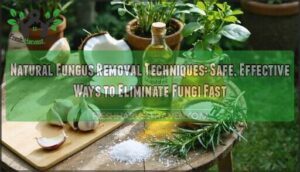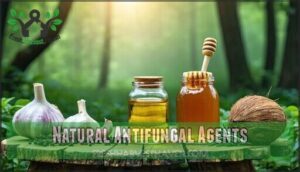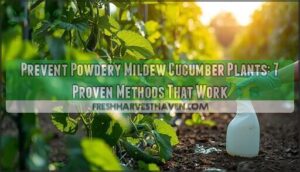This site is supported by our readers. We may earn a commission, at no cost to you, if you purchase through links.
 Natural fungus removal techniques give you practical tools to reclaim your space and body from pesky fungi.
Natural fungus removal techniques give you practical tools to reclaim your space and body from pesky fungi.
Garlic and coconut oil team up to fight off trouble, while tea tree oil and apple cider vinegar tackle infections on the surface.
Baking soda and Epsom salt soaks soothe your skin and keep fungus on its toes.
Keep things simple: wash daily, let your feet breathe, and stick with these remedies for steady results.
Don’t forget, keeping things clean and dry is half the battle.
Curious about how to blend these methods into your daily habits? There’s more where that came from.
Table Of Contents
- Key Takeaways
- Fungal Infection Causes
- Natural Antifungal Agents
- Home Remedies for Fungus
- Antifungal Foods and Herbs
- Treating Fungal Infections Naturally
- Frequently Asked Questions (FAQs)
- Can plant fungus be treated naturally?
- How do you get rid of fungi at home?
- How can I prevent and treat fungal infections naturally?
- How do you remove fungus from plants?
- How to get rid of a fungal infection at home?
- How do I get rid of fungus on my Skin?
- What are fungal infections and what causes them?
- How can I identify a fungal infection?
- Are natural remedies effective against fungal infections?
- What are the top natural remedies for fungal infections?
- Conclusion
Key Takeaways
- Keep your skin clean and dry, since moisture and sweat make it easier for fungus to grow.
- Use simple natural remedies like tea tree oil, garlic, coconut oil, and apple cider vinegar to fight mild fungal infections.
- Add antifungal foods such as garlic, coconut oil, and probiotics to your diet for better internal defense.
- Stick to breathable clothing, don’t share personal items, and wash linens in hot water to prevent reinfection.
Fungal Infection Causes
You can get a fungal infection when your body’s defenses weaken or your environment gives fungi an easy place to grow.
Common causes include taking antibiotics, eating lots of sugar, or spending time in warm, damp areas, which can be considered a complete concept for fungal infection causes.
Candida Overgrowth Symptoms
When Candida overgrowth takes the reins, your body sends out signals you shouldn’t overlook. Those unexplained digestive issues, random mental fog, and nagging joint pain often point to a brewing problem below the surface.
Here’s what to watch for:
- Recurring fungal infections like oral thrush, skin rashes, or stubborn nail fungus that just won’t quit
- Fatigue symptoms that linger even after a restful night’s sleep
- Digestive issues including bloating, cramps, and unpredictable bowel movements
Candidiasis thrives when your defenses are down, particularly after antibiotics or too much sugar. Turning to natural antifungal methods and foods with antifungal properties can help restore balance and get you feeling like yourself again. Understanding genetic candidiasis factors is essential in addressing recurring infections.
Systemic Infections and Candidiasis
When your body’s defenses slip, once-harmless fungus can spark a wildfire: systemic candidiasis.
This serious infection travels the bloodstream, targeting your organs and often mimicking other illnesses, which can fool even professionals.
If invasive Candidiasis sets in, it’s a race against time—mortality rates can reach 40%.
Spotting it early is critical.
Treatment means powerful antifungal medications, gut health support, and an antifungal diet.
Prioritize immune boosters and natural fungus removal habits for proper Candida treatment and a systemic cure.
| Condition Type | Mortality Rate |
|---|---|
| Invasive Candidiasis | 40% mortality |
| Candidemia | Bloodstream infection |
| Organ Involvement | Multiple systems |
| Treatment Options | Antifungal medications |
Risk Factors for Fungal Infections
How do you steer clear of stubborn fungal infections? Simple habits and your environment play a bigger role than you might think.
Let’s break down four main risk factors for fungal infection causes:
- Poor hygiene—leaving moisture on your skin gives fungi a welcome mat.
- Humid climates—warm, wet air is a fungus’s dream, especially paired with excessive sweating.
- Shared items—towels, shoes, and clothing can all transfer fungal spores.
- Tight clothing—traps moisture, blocks airflow, and increases the odds for anyone with a high sugar diet or weak immune system.
Understanding disease prevention strategies is vital to minimizing the risk of fungal infections.
Natural Antifungal Agents
You can use natural antifungal agents like garlic, coconut oil, and manuka honey to target and eliminate fungi quickly.
These options work by disrupting fungal cell walls and creating environments that fungi can’t survive in, which is made possible by the use of natural antifungal agents.
Garlic and Coconut Oil Benefits
If you’re tired of stubborn fungi hanging around, check out your kitchen.
Garlic’s antifungal properties come from allicin, a special compound released when you crush a fresh clove.
This natural remedy weakens fungal cell walls and helps boost your fungal resistance.
Coconut oil offers caprylic acid—nature’s own defense system—creating an environment fungi can’t stand.
For the best antifungal synergy and quick natural fungus removal, use both together:
- Mix crushed garlic with virgin coconut oil and apply directly to affected skin.
- Add 2-3 cloves of raw garlic to meals, and take 1-2 tablespoons of coconut oil daily.
- Use these antifungal agents routinely to maximize coconut benefits and keep fungi from returning.
Understanding garlic oil benefits, such as garlic oil uses, can enhance your natural fungus removal techniques.
Manuka Honey and Oregano Oil Uses
Endurance meets relief when you use Manuka honey and oregano oil as part of your fungal treatment routine.
Manuka honey’s unique antifungal properties target stubborn spots, whether you apply a thin layer to your skin or enjoy the honey benefits in tea.
Oregano oil therapy delivers quick results, but always dilute it—a little goes a long way.
These natural remedies provide effective, chemical-free fungal treatment and fit neatly into any natural antifungal methods routine.
Use the table below for quick application tips:
Pau D’arco and Kefir for Candida
When you want effective Candida treatment, Pau Darco’s benefits shine. This natural remedy offers antifungal properties, supporting your quest for fungal prevention.
Pairing it with kefir probiotics creates a strong one-two punch for gut health. If you’re using natural antifungal methods, here’s what you should know:
- Restores gut flora balance
- Helps crowd out Candida
- Supports your immune system
- Can trigger mild die-off symptoms (a good sign)
- Encourages long-term fungal prevention
Using natural disease remedies plants can help with overall health and wellness by utilizing plant based treatments.
Home Remedies for Fungus
You can use proven home remedies to fight fungal infections with ingredients like tea tree oil, apple cider vinegar, baking soda, and Epsom salt.
These options are easy to find, and they help stop fungus and support your skin’s natural balance.
Foot Fungus Treatments and Prevention
In the context of Foot Care and Fungus Prevention, don’t let foot fungus run the show.
Good Foot Hygiene is your frontline defense—wash your feet daily and dry well between each toe, because dampness makes a perfect playground for fungus.
Switch to cotton socks and rotate your shoes, letting them dry out fully between uses.
For fungal infection treatment at home, try soaking your feet in warm water mixed with baking soda or Epsom salt; both act as natural antifungal methods and simple homemade fungicides.
If Athlete Foot or Toenail Fungus lingers, dilute tea tree oil in coconut oil and gently apply.
Keep toenails trimmed short and avoid barefoot walks in public showers.
Precise habits like these tap into antifungal properties, helping you walk free and clear.
Tea Tree Oil and Apple Cider Vinegar Uses
Moving from feet to broader skin care, let’s talk about Tea Tree Benefits and Apple Cider Remedies for natural fungus removal.
Tea tree oil and apple cider vinegar stand out for their potent antifungal properties—no hype, just facts.
Here’s a simple routine:
- Dilute tea tree oil with coconut oil (1:10) to lower skin sensitivity.
- Mix apple cider vinegar with equal parts water for a gentler touch.
- Always patch test your skin for reactions before full use.
- Apply the mixture twice daily using cotton swabs for precise Fungal Skin Care.
- Limit apple cider vinegar soaks to 15-20 minutes—no marathon baths needed.
These home fungus remedies support healthy, resilient skin.
For effective nail fungus treatment, consider using tea tree oil remedies as part of your routine to achieve natural fungus removal and promote overall skin health with potent antifungal properties.
Baking Soda and Epsom Salt Soaks
After you’ve explored tea tree oil and apple cider vinegar, consider a dependable remedy: the baking soda and Epsom salt Foot Soak.
Baking soda’s antifungal properties help disrupt fungus, while Epsom salt offers Salt Benefits by soothing irritation and calming swelling.
Just add half a cup of each to warm water, soak your feet, and let Skin Therapy go to work.
This simple Fungal Remedy is one of the best Natural Cures—low-cost, effective, and a quick step toward natural fungus removal.
For ideal results, understanding baking soda benefits is essential to creating an effective soak.
Antifungal Foods and Herbs
You can support your body’s natural defenses by adding antifungal foods and herbs such as garlic, coconut oil, and manuka honey to your routine.
Science shows these options work against common fungi, so you’ll have more ways to keep infections in check, using antifungal foods and herbs.
Garlic and Coconut Oil Antifungal Properties
When fungus overstays its welcome, you can turn to natural remedies that put up a real fight.
Garlic wins top honors for its powerful antifungal properties—thanks to allicin, a compound known for disrupting stubborn fungal resistance.
Pair it with coconut oil, packed with caprylic acid, and you get an antifungal blend worth trying.
This combo attacks fungus head-on, both inside and out.
- Mix crushed garlic with coconut oil for a potent antifungal agent
- Apply directly to problem areas twice daily for best results
- Eat raw garlic cloves to boost internal natural fungus removal
- Keep garlic-coconut mixtures cool for maximum freshness
Easy, practical, and effective.
Understanding natural fungicide methods is essential for effective fungus control.
Manuka Honey and Pau D’arco Benefits
When you want nature’s heavy hitters on your side for natural fungus removal, Manuka honey and Pau d’Arco step up.
Reach for Manuka honey if you want an antiseptic edge—its thick texture locks out moisture, and the unique sugars crank up osmotic pressure that weakens fungal cells.
Pau d’Arco, made from tree bark, hits fungus from the inside with herbal compounds traditional healers have trusted for centuries.
A cup of Pau d’Arco tea or a supplement might nudge your body back toward balance.
Together, these antifungal agents are tough on fungal infections while gentle on you.
| Feature | Manuka Honey Benefits | Pau D’Arco Features |
|---|---|---|
| Action | Osmotic pressure | Cell wall disruption |
| Common Use | Honey remedies, wounds | Tea, immune support |
| Natural Cures | Topical, diluted | Capsules, brewed |
Kefir and Probiotics for Gut Health
If you’re chasing real gut health, kefir and probiotics are your secret weapons for natural fungus removal.
Kefir’s 60+ live strains support a thriving gut microbiome, making it tough for Candida to take hold.
These probiotic-rich foods help you absorb essential nutrients and keep your immune system on standby.
As for results, you’ll notice:
- More microbe balance against infection
- Smoother gut healing and less discomfort
- Better pH levels that deter fungus
- Probiotic supplements that deliver on antifungal probiotics
The benefits of using kefir and probiotics for gut health are numerous, and they can be a great addition to a healthy lifestyle.
Treating Fungal Infections Naturally
You can treat fungal infections naturally using safe, evidence-based methods at home.
By applying proven remedies and making simple changes to your routine, you’ll reduce fungi fast and support healthy skin.
Plant Fungus Remedies and Prevention
Plant fungus can be a sneaky intruder, but you’ve got plenty of organic gardening tricks to keep it in check.
Try thyme decoctions, sage solutions, or lavender antifungals—these natural fungicides offer solid Fungus Control and Garden Hygiene.
Mix garlic and water for a homemade fungicide spray; cornmeal fungicides encourage good soil microbes.
Baking soda works for both Plant Care and Lawn Maintenance, helping to stop fungus before it spreads.
Cut away dead plant matter, let your plants breathe, and make sure the soil drains well.
These DIY antifungals keep your space safe, healthy, and chemical-free.
Nail Fungus Treatments and Home Remedies
Battling a stubborn fungal nail infection can feel like an uphill climb, but safe, effective solutions are right at your fingertips.
Try these five natural nail fungus treatments to boost nail care and promote healthy nails:
- Tea tree oil: Apply directly, twice daily. Its antifungal essential oils attack the fungus at the source.
- Apple cider vinegar soaks: Soak nails for 10–40 minutes daily; the acidity helps balance pH and slows fungal nail infection.
- Vicks VapoRub: Spread a thin layer on nails twice a day; camphor and menthol target fungi.
- Baking soda paste: Mix with water to form a homemade fungus solution that neutralizes odor and disrupts fungus growth.
- Listerine soaks: Gold-colored Listerine offers thymol, a natural antifungal, as a quick foot hygiene boost.
Using tea tree products can enhance the effectiveness of these treatments. Consistency brings results—stick with these home remedies for real nail fungus removal.
Hygiene and Cleanliness for Fungal Prevention
After tackling nail fungus, staying fungus-free comes down to steady habits.
Personal hygiene is your secret weapon: wash and dry every nook, especially between toes and skin folds.
Don’t let sweaty socks linger—choose breathable fabrics, keep shoes aired out, and never swap towels or socks.
Consistent nail trimming blocks the buildup fungi thrive on.
Laundry practices matter too—wash clothes and linens in hot water.
At home, moisture control and good airflow shut down fungus before it settles in.
A clean environment and mindful daily routines make fungal prevention almost second nature.
Call it your natural fungicide in action.
Frequently Asked Questions (FAQs)
Can plant fungus be treated naturally?
Here’s a surprise: organic mulch replacement slashes soil fungus risk by 75%.
You can treat fungus on plants with homemade sprays—baking soda, vinegar, or neem oil.
Just follow directions, spray regularly, and watch your garden bounce back to recovery.
How do you get rid of fungi at home?
Keep your home dry and well-ventilated—fungi hate fresh air.
Scrub surfaces with diluted vinegar or baking soda.
Toss out damp items, don’t let leaks linger, and use dehumidifiers to kick out stubborn mold for good.
How can I prevent and treat fungal infections naturally?
Wash with mild soap, dry well, and slip into cotton—synthetics just fuel the fungal fire.
Dab diluted tea tree oil, coconut oil, or apple cider vinegar on infections.
Cut sugary snacks and let sunlight work its magic.
How do you remove fungus from plants?
Mix baking soda, mild soap, and water for a quick spray.
Use apple cider vinegar or neem oil weekly to treat leaves.
Remember, watering in the morning and trimming nearby plants helps fungus pack its bags and move out, with complete concepts like these being crucial for a healthy garden.
How to get rid of a fungal infection at home?
Fungal infections can be stubborn, but you can fight back.
Apply diluted tea tree oil, coconut oil, or apple cider vinegar to affected skin.
Keep the area dry, wear loose clothes, and don’t share towels, to help prevent the infections from spreading.
How do I get rid of fungus on my Skin?
Fighting skin fungus can feel like wrestling an octopus—it’s slippery and stubborn.
Dry your skin well, use diluted tea tree oil or apple cider vinegar, wear loose clothes, and don’t share towels.
Apply remedies daily for best results.
What are fungal infections and what causes them?
When your body’s defenses drop, sneaky fungi like Candida see an opening and start to party.
Things like antibiotics, stress, or sweaty clothes give them free rein—causing itchy rashes, digestion trouble, or sometimes, worse.
Stay watchful!
How can I identify a fungal infection?
You might notice itchy, red patches, peeling skin, or stubborn rashes, often in warm, damp spots.
Sometimes there’s odor, swelling, or even cracking between toes.
If creams don’t help, ring up your doctor—don’t just “let it slide” because you should consult a professional for proper treatment.
Are natural remedies effective against fungal infections?
You’ll find natural remedies like tea tree oil, garlic, and coconut oil can help clear up mild fungal infections.
Stick to a routine and give them time—nature doesn’t always rush, but her solutions are steady and safe.
What are the top natural remedies for fungal infections?
Up to 80% of fungal spots stop spreading if caught early and treated.
You can rely on tea tree oil, diluted apple cider vinegar, coconut oil, garlic, and plain yogurt—these natural remedies fight fungus while supporting your skin’s defenses, with natural remedies being key to this approach.
Conclusion
Like a well-oiled machine, applying natural fungus removal techniques helps you keep fungi out of your daily life.
Stick with proven remedies, keep your spaces clean, and give fungi fewer chances to take hold.
You’ve learned how garlic, coconut oil, and probiotics work as effective tools.
Don’t skip daily hygiene—prevention truly pays off.
Use these methods and you’ll reduce the risk of stubborn infections.
With these steps, you’re set up for a fungus-free future.
- https://www.healthline.com/nutrition/candida-symptoms-treatment
- https://articles.mercola.com/herbal-oils/oregano-oil.aspx
- https://www.gardeningknowhow.com/ornamental/flowers/painted-daisy/painted-daisy-plants.htm
- https://www.frontiersin.org/journals/microbiology/articles/10.3389/fmicb.2015.01391/full
- https://www.cdc.gov/candidiasis/signs-symptoms/index.html











